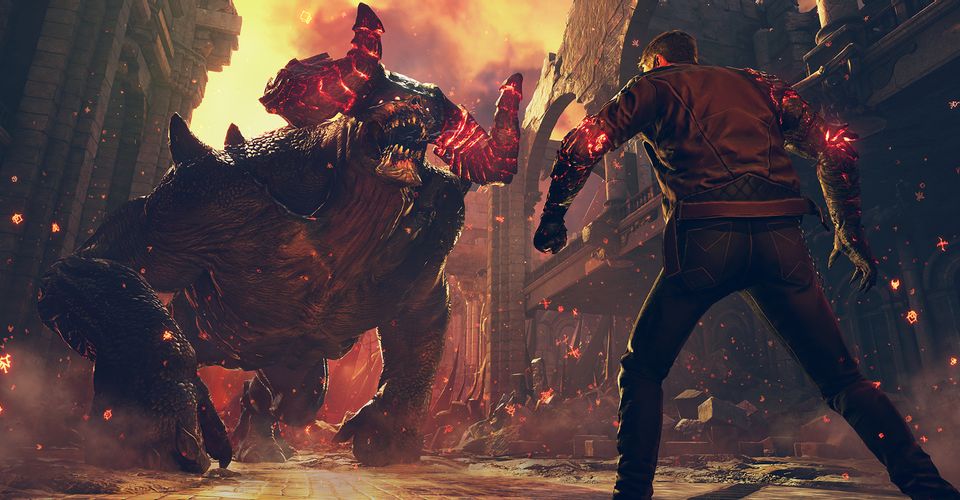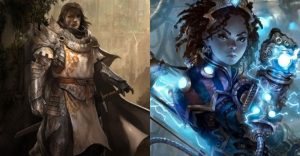Devil’s Hunt Review: This Ungodly Story Can’t Be Redeemed

Devil’s Hunt has a laughably bad plot, rotten protagonist, and outdated mechanics, but mediocre combat and excellent visuals keep it out of the fire.
An ambitious indie that aims to be a power fantasy of divine proportions, Devil’s Hunt is visually impressive for its scope but drops the ball in nearly every other respect. Freshman developer Layopi Games was founded by Polish author Paweł Leśniak with the goal of bringing his Equilibrium series from the page to the gamepad, and, to their credit, the end result is a serviceable (if uninspired) brawler that paces itself well enough to keep players engaged until the condensed adventure’s end. Though it’s mechanically repetitive, leans heavily on outdated level design philosophies, and poorly veils its unfinished state as sequel-baiting, it’s actually the adapted story of boxer-turned-demon Desmond Pearce’s meteoric rise from selfish murderer to inscrutably dense chosen one that elevates the experience into Metal Wolf Chaos levels of absurdity without a fraction of the self-aware charm.
Exploring the room for ambiguity in Christianity’s thematic representation of angels and demons, Devil’s Hunt is set in a world where heaven and hell are equally defined by paperwork and in-fighting as they each prepare for their imminent earthly clash, which sounds pretty interesting on its face. It probably would be, too, were it not for the fact that wise-cracking Desmond Pearce has made a deal with the devil after arriving in hell after death, becoming both Lucifer’s newest soul-harvesting Executor and players’ nightmarishly boorish lens into the game world.
Like Duke Nukem but completely unfunny and somehow more obnoxious, it seems that Devil’s Hunt wants more than anything than for players to believe that its protagonist is a Cool Tough Guy™ when he’s really just a horrible character. In the most tactless suicide depicted in modern gaming, Desmond suddenly drives his car off a bridge (without ideation or so much as a depressive episode) after being fired from his vague executive position at his dad’s massive company, losing an underground boxing match to a man literally named “The Saw” (an event at which his father was for some reason in attendance), and subsequently catching sight of his fianceé, Kristen, and best friend, Embry, fully clothed together in his bedroom. All too matter-of-factly, Desmond goes to hell for taking his own life, with no further commentary or implications being provided on that sensitive topic beyond the event, itself, and its immediate consequence.

Desmond’s first instinct in the most overt, pools-of-blood-and-lava-everywhere portrayal of hell is to start punching demons to death while bumbling around the abyss remarking how “unnatural” the place looks, inexplicably unshaken by what drove him to suicide. Within minutes, he’s ambushing massive, smoldering demons, making such humbled remarks as, “Surprise, assholes!” and, “Don’t run, I’m only gonna kill ya!” Resurrected, Desmond exhumes himself wearing the same outfit he died in with nary a loose thread to break into Embry’s apartment and stab him to death. He also takes time to begin stalking an apparently less guilty Kristen from afar, much to the chagrin of his demonic handlers – one of which is The Saw, and he’s very bad! By its abrupt end, Devil’s Hunt just gives up on trying to juggle its own convolution. Crowning The Saw as final boss and dropping a main plot thread, Desmond, Kristen, and a forgiven angel Embry are thrown into a sunset-bound car to go figure it out in a potential sequel.
At no point in the game’s half-dozen or so hours will players likely connect with Desmond on any level beyond disdain or abject confusion, and this is likely to be true for most of Devil’s Hunt‘s characters. This is due in no small part to their stony facial animations, which rarely correlate with the human emotions present in the dialogue, exacerbated by mouth movements that tend to fall in and out of sync. Being an action game first and foremost, these problems could be ignored were it not for the complete misuse of quality voice talent on display. Aside from a couple of standout exceptions, it’s painfully clear that numerous voice actors of obvious skill were poorly directed to read weightless, bargain bin lines, resulting in almost every character sounding variably erratic or disinterested in an already extremely disjointed story.

If Devil’s Hunt‘s narrative and characters are remarkably bad, then its combat is simply unremarkable. It does a decent job of carrying the experience forward, mainly in its use of three schools of action skills and combos that players can switch up on the fly. Souls are picked up from defeated foes and found in the environment, and they stand in for traditional experience points with which to upgrade Desmond’s abilities. Each school is distinct not only visually in terms of corresponding colors appearing on Desmond’s demon arms, but also in the type of attacks they enable; the hellish Executor tree excels at dealing large blows one at a time, while the vaguely biblical Unholy school is best used for DPS and crowd control. Unfortunately, most of the poignantly balanced Void moves are tied to plot events that are either hidden or wholly absent from the game – a disappointment, as the available slowing ability and God Hand-like combos are the most satisfying on offer.
Although there’s a sufficient variety in enemy types (namely among hell’s force’s, which receive most of the player’s attention throughout the game), Devil’s Hunt relies heavily on very similar enemy patterns for large chunks of the game. When combined with higher counts of attackers and Desmond’s expanding arsenal of moves – each with their own individual cooldown – combat quickly transitions from a somewhat thoughtful and rewarding sweet spot toward the middle into an exercise in spamming every available ability while waiting for the others to charge. This descent into monotony, in addition to below-average camera controls and the absence of lock-on targeting, limit combat from being any better than so-so.

Exposition, combat, and exploration all make up approximately equal thirds of Devil’s Hunt when played on its standard difficulty, with that latter slice stemming mostly from traversing the empty spaces between fights as Desmond pushes up corridors between objectives. Not shy of tasking the player with busy work, there are a bevvy of over-animated context-sensitive “press A to progress” moments to pad out the time spent between servings of the game’s meatier gameplay sections. To an excessive degree, players must sit through the same animations of Desmond squeezing between gaps, shouldering open doors, and sidling across narrow platforms from which he can’t even be fall off. Sometimes there are non-critical paths to be explored that will reward players with extra souls, but it’s just as often that they lead to dead ends. That is, until the final act, at which point the game is desperate to give players any skills yet to be unlocked.
In a tragic twist of fate, it’s ultimately the visual design that stands out as the crowning achievement here, with environmental design being a particular stand-out. From start to finish, it’s an aesthetically pleasing blend of Hell’s sharp and brutal gothic ruins, the angel faction’s stylishly sanitized urbanist architecture, and natural edifices both jagged and serene. Even in the face of occasional texture pop-in and a handful of persistent bugs, it’s no understatement to say that Devil’s Hunt is one of the most graphically taxing indies out there. That’s also a testament to the prowess of Layopi Games’s programmers, who somehow got this beautiful mess to run as well as it does with no crashes. Without a doubt, both teams are the young studio’s most talented assets. It can only be hoped that the 2020 console release features a photo mode with which to capture the game’s impressive vistas.

Maybe if the storyline felt complete and the ending didn’t unceremoniously rush the player through half-baked boss encounters, Devil’s Hunt‘s narrative could migrate into “so bad it’s good” territory. However, as it is, Layopi Games’s first stab at weaving an interactive tale from its founder’s written source material leaves nowhere to go from here but up. High-quality textures and world design that capture the imagination only go so far when the movement and combat that they’re supposed to complement only perform at a range between mundane and adequate.
Devil’s Hunt is now available for PC and is coming to PS4, Xbox One, and Nintendo Switch in Q1 2020. Screen Rant was provided a PC code for the purpose of this review.
About The Author


















